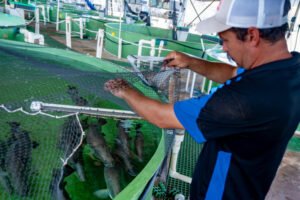Wednesday, 17 December 2025
New Chemistry of Cheese: Inside R&D Behind Next Plant-Based Breakthrough
Professor Cordelia Selomulya, Dr Yong Wang and Canice Yiu As the demand for plant-based foods continues to grow, one category has struggled to match the sensory and nutritional appeal of…

Professor Cordelia Selomulya, Dr Yong Wang and Canice Yiu
As the demand for plant-based foods continues to grow, one category has struggled to match the sensory and nutritional appeal of its animal-based counterpart: cheese. While plant-based meats have made significant progress, many vegan cheeses still fall short, lacking the melt, stretch, and savoury satisfaction that define traditional dairy products.
However, a research team from UNSW Sydney, led by Professor Cordelia Selomulya, Dr Yong Wang and Canice Yiu is challenging this status quo. Combining their expertise in food engineering and protein chemistry, they have developed an innovative formulation that mimics the functional performance of dairy cheese, especially its iconic melt and stretch, while significantly enhancing the nutritional profile. By using a novel combination of plant proteins and thermally responsive polysaccharides, the team has created a cheese alternative that not only tastes and cooks like the real thing but also meets health and sustainability goals.
In an exclusive interview with NUFFOODS Spectrum, the team discusses the science behind their breakthrough, the gaps in current market offerings they aim to fill, and why their work could represent a turning point for innovation in plant-based dairy products.
What was the initial inspiration for your team to concentrate on mimicking the structure and texture of dairy cheese using plant proteins and polysaccharides?
We were inspired to start this project after taking a closer look at what was already out there in the plant-based cheese space. It became clear that many of the existing products weren’t quite hitting the mark, especially when compared to dairy cheese.
There were two main issues we kept seeing. Nutritionally, a lot of plant-based cheeses are low in protein, which isn’t ideal for people trying to make a healthy switch from dairy. On top of that, many rely on high levels of saturated fat to get the right texture, which raises health concerns.
The second challenge was performance. These cheeses might look fine on a platter, but when it comes to cooking properties like melting, stretching and browning, they often fall short. They just don’t behave like real cheese in the kitchen.
That’s the gap we set out to fill. We wanted to create a plant-based cheese that not only delivers on nutrition but also performs beautifully when cooked. That’s what led us to experiment with plant proteins and polysaccharides in a whole new way.
Could you elaborate on the specific role of polysaccharides in enabling the melt and stretch characteristics of your plant-based cheese?
We noticed that different polysaccharides have varying thermal properties that affects their structure under heat. Consider how we set jelly with gelatine or how we make a roux with flour. We have devised a way to combine the two polysaccharides where one could easily “melt” before the other one could develop its stretchy network during heating. The arrangement gives us a couple of advantages. This include creating a solid yet spreadable material to spread over food, the opportunity to recreate the melting behaviour of cheese upon heating, and with a soft texture when eaten.
In what ways does your innovative cheese enhance the nutritional profile of plant-based cheeses, particularly when compared to current market offerings?
Our new formulation incorporates a considerable amount plant protein to maintain the stability of the formulation. Current market offerings typically use varying amounts of modified starches and plant-based fat to create cheese-like properties, often without any proteins included in their products. This stands in contrast to dairy cheeses, renowned as a rich source of protein in our diet.
We believe our approach is a step in the right direction, where we could make fewer compromises when considering plant-based options.
A common hurdle for plant-based alternatives is their performance during cooking and storage. How does your cheese perform under typical cooking conditions and during extended storage?
Our tests show that our formulation was able to better mimic the melting behaviour that we typically see in dairy cheeses, including how the individual strands of cheese melted and spread together when heated. This is usually not possible with current offerings as there isn’t really any “melted” and flowable state when heated.
We also ran stability tests on our current formulation, especially over multiple freeze-thaw cycles. They show high degrees of resistance to temperature fluctuations which is important in the handling and transportation of frozen food. The next step will be to look into extended storage stability for these formulations.
What are the plans for bringing your cheese to market? Have you seen interest from food manufacturers or startups within the plant-based industry?
We have already attracted interest from several companies in the food industry, ranging from innovative startups to more specialised manufacturers in the plant-based sector. We are open to a variety of collaborative models, as our focus is on developing and providing the core technology. That’s why building strong, strategic partnerships is essential for us. It’s through these partnerships that we can help bring this innovation to market and make a real impact.
Considering the future landscape, how do you anticipate that plant protein and food engineering technologies will shape the evolution of dairy and meat alternatives in mainstream diets?
We see plant-based foods, and more broadly, alternative proteins, as an important part of expanding dietary choices, whether for people with specific nutritional needs or those aiming to adopt a more sustainable lifestyle. This sector is poised for long-term growth, but that growth depends on delivering products that offer appealing textures and an enjoyable overall eating experience.
At the same time, we don’t view these alternatives as replacements for dairy or meat. Rather, they’re about broadening the range of options available to consumers, regardless of their focus, whether it is on health, sustainability, or simply discovering new tastes and culinary experiences.
Shraddha Warde
shraddha.warde@mmactiv.com
Technology
Nfinite secures funding to scale up breakthrough paper packaging solution
Dec 17, 2025 | Company News
Silal–Square Roots partnership uses AI to boost sustainable food production
Dec 17, 2025 | Company News
Food Testing
Australia’s Humpty Doo Barramundi farm to achieve ASC certification
Dec 08, 2025 | Australia
SFDA and Turkish Halal Accreditation Agency forge strategic partnership
Dec 05, 2025 | Food
Fish freshness easily monitored with a new sensor
Dec 04, 2025 | Food Safety and Testing
More Popular
Nfinite secures funding to scale up breakthrough paper packaging solution
Dec 17, 2025 | Company News
Silal–Square Roots partnership uses AI to boost sustainable food production
Dec 17, 2025 | Company News
Korea's Samson Food broadens seafood portfolio with hwangto salt-based products
Dec 17, 2025 | Company News






